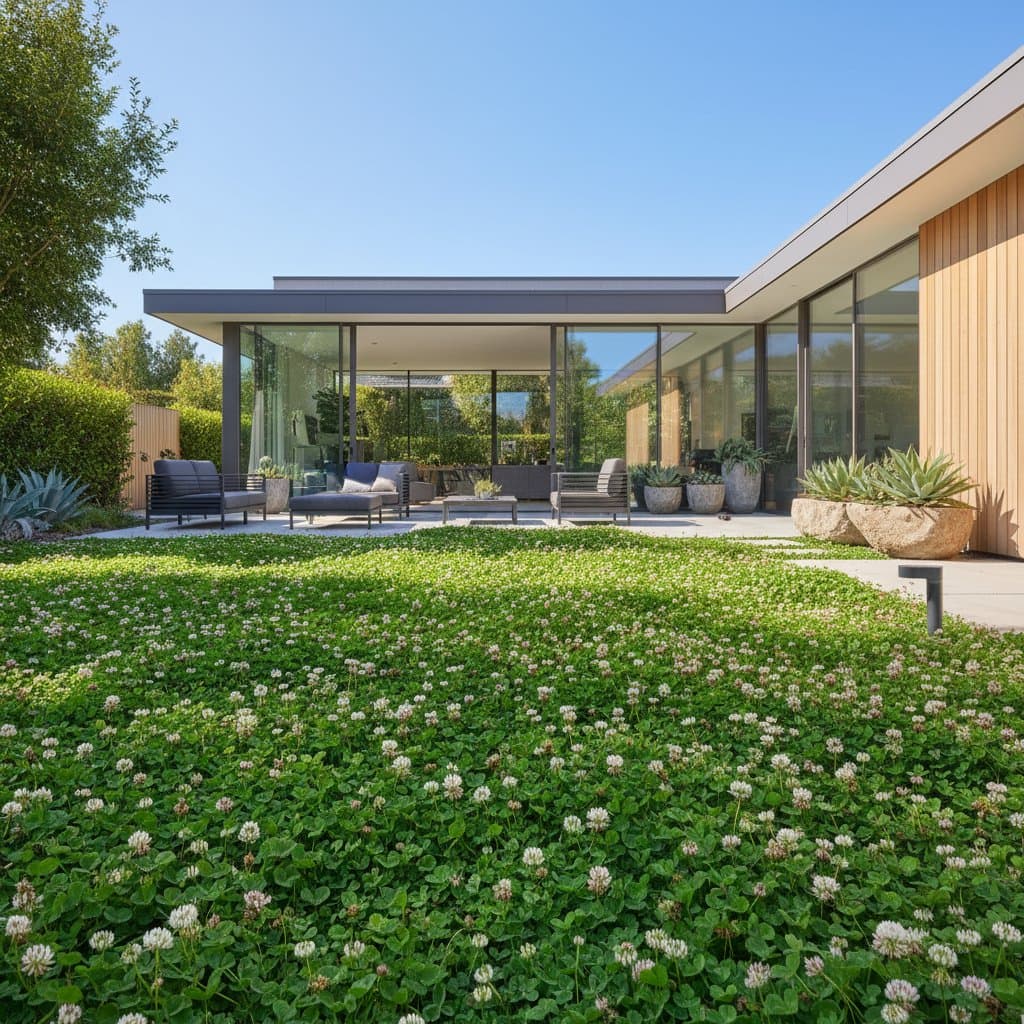Why Homeowners Choose Clover Over Grass in 2025
Homeowners in areas such as California now regard a thriving yard as an extension of sustainable living rather than a mere display of affluence. Conventional grass lawns exact a heavy toll in terms of time, money, and resources, which drives many individuals toward clover as a resilient substitute. This shift prioritizes practicality, aesthetic charm, and ecological stewardship, enabling landscapes to thrive with reduced oversight.
Challenges of Maintaining Traditional Grass Lawns
Achieving a pristine grass lawn demands ongoing vigilance and effort. Property owners typically mow every week during vigorous growth periods, fertilize several times annually, and water extensively to avert discoloration during hot spells. In dry climates, these routines deplete substantial water volumes, surpassing 10,000 gallons per residence each year.
Compacted earth and shaded zones exacerbate maintenance difficulties, resulting in sparse areas that necessitate reseeding or sod installation. Infestations of pests and encroaching weeds intensify the labor, while chemical interventions threaten household pets and nearby water bodies. These burdens prompt numerous individuals to reevaluate the merits of preserving a grass-centric yard.
Advantages of Clover as a Lawn Alternative
Clover presents a sturdy option for individuals desiring an undemanding verdant area. This plant thrives in conditions ranging from full sunlight to partial shade and endures periods of drought once its roots penetrate deeply into the earth. Through nitrogen fixation from the air, clover naturally fortifies the soil, rendering commercial fertilizers unnecessary.
The foliage offers a plush texture ideal for walking barefoot or engaging in leisure activities, thereby amplifying the pleasure of outdoor spaces. Intermittent white or pink blossoms attract vital pollinators, promoting ecological diversity even in urban neighborhoods. In essence, clover imparts a lively, organic appearance that harmonizes effortlessly with adjacent plantings.
Key Practical Benefits of Clover Lawns
Clover lawns streamline routine landscape upkeep via distinct, practical gains:
-
Water Conservation
Clover's extensive roots access moisture from deeper soil strata, sustaining its vibrancy with 50 to 75 percent less watering compared to grass. In temperate regions, program irrigation systems to activate every five to seven days, thereby safeguarding community water reserves. -
Minimal Mowing Requirements
Clover grows to four to six inches before requiring attention, typically demanding only three to four cuts per year. Adjust mower heights to two inches to encourage robust expansion while avoiding plant strain. -
Built-In Weed Suppression
The dense clover canopy deprives weed seeds of light, curbing outbreaks by as much as 90 percent. Introduce fresh seeds each autumn to sustain thickness and eliminate vulnerabilities. -
Durability for Pets and Play
Clover withstands pet urine without lasting harm, recovering its green hue in mere days thanks to its rapid regeneration. The yielding surface absorbs impacts more effectively than rigid grass, rendering it appropriate for family recreation. -
Soil Health Improvement
Annual nitrogen contributions reach up to 150 pounds per acre, nourishing neighboring vegetation and slashing fertilizer expenses by at least half. This mechanism also refines soil composition, enhancing percolation and aeration progressively.
Selecting the Ideal Clover Variety
Property owners must evaluate particular clover species to align with their site's conditions. Microclover, characterized by slender leaflets and limited blooms, yields a polished, grass-resembling surface that necessitates infrequent trimming. Incorporate it into current lawns by scattering two to four pounds of seed across every 1,000 square feet.
Dutch white clover, featuring wider foliage and prolific flowers, appeals to those envisioning a meadow-like ambiance. Distribute one to two pounds per 1,000 square feet to achieve comprehensive coverage. For enhanced adaptability, mix 70 percent microclover with 30 percent fescue grass, merging endurance with refined texture.
Evaluate soil acidity in advance, targeting a pH between 6.0 and 7.0, and incorporate lime as required to foster optimal development. Seek guidance from regional agricultural extensions for seeds suited to local climates.
Steps to Convert Your Lawn to Clover
Converting an established grass area to clover requires methodical groundwork to secure enduring success. Initiate the process in early spring or autumn by clipping the current turf closely and clearing refuse. Employ a core aerator on firm ground to facilitate seed adhesion to the soil.
If persistent broadleaf weeds prevail, deploy a pre-emergent herbicide, followed by raking to level the terrain. Disperse seeds uniformly via a broadcast spreader at specified densities, then compact them gently with a roller. Irrigate consistently with one inch weekly until sprouts emerge in seven to 14 days.
Taper watering frequency as the root network strengthens, favoring profound, sporadic applications. Address sparse regions with additional seeding after the initial month to guarantee uniform establishment. By the conclusion of one growth cycle, clover forms a resilient mat capable of moderate use.
Integrating Clover for Lasting Landscape Resilience
Embracing clover supports overarching objectives of resource conservation and wildlife enhancement. Residents frequently note annual reductions of several hundred dollars in water bills and maintenance products, coupled with diminished physical exertion. Such strategies convert properties into functional habitats that appreciate in worth.
Vigilantly observe for minor threats like clover mites, addressing them with natural soap solutions when appropriate. Complement clover plantings with indigenous perennials to introduce variety and bolster pollinator activity. Through these measures, clover surpasses grass as a mere replacement, evolving the yard into a durable, inviting retreat.

